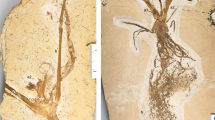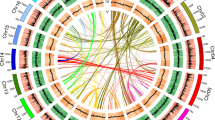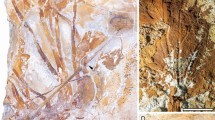Abstract
THE Kranz syndrome1,2 is a group of physiological and anatomical features occurring in certain angiosperms; the grasses in particular show increasing efficiency in CO2 assimilation. Recent research3,4 suggests an origin of the syndrome in South America and its subsequent dominance in other continents. The Kranz syndrome occurs in all plants fixing CO2 by phosphoenolpyruvate carboxylase in the mesophyll and subsequent production of Calvin–Benson cycle intermediates in the bundle sheath5. The physiological processes in C4 plants are closely related to their specialised leaf anatomy known as Kranz anatomy6 by which they are distinguished from C3 plants. It is suggested that ancestral non-Kranz C3 grasses originated during the Cretaceous period4. We report here fossil evidence indicating that C4 plants occurred at least during the late Tertiary period.
This is a preview of subscription content, access via your institution
Access options
Subscribe to this journal
Receive 51 print issues and online access
$199.00 per year
only $3.90 per issue
Buy this article
- Purchase on Springer Link
- Instant access to full article PDF
Prices may be subject to local taxes which are calculated during checkout
Similar content being viewed by others
References
Treguma, E. B., Smith, B. N., Berry, J. A. & Downtown, W. J. S. Can. J. Bot. 48, 1209–1214 (1970).
Smith, B. N. & Epstein, S. Pl. Physiol. 47, 380–384 (1971).
Hartley, W. Aust. J. Bot. 6, 343–357 (1958).
Brown, W. V. & Smith, B. N. Nature 239, 345–346 (1972).
Hatch, M. D. CO2 Metabolism and Plant Productivity, 59–81 (University Park Press, Baltimore, 1976).
Johnson, S. C. & Brown, W. V. Am. J. Bot. 60, 727–735 (1973).
Hattersley, P. W. & Watson, L. Phytomorphology 25, 325–333 (1975).
Smith, B. N. & Brown, W. V. Am. J. Bot. 60, 505–513 (1973).
Chitaley, S. D. & Sheikh, M. T. J. Indian Bot. Soc. 50, 137–142 (1971).
Thomasson, J. R. Science 199, 975–977 (1978).
Weber, I. E. Carnegie Inst. Wash. Publ. No. 412, 115–134 (1933).
Merriam, J. C. Univ. Calif. Publ. Bull. Dept Geol. 2, 437a–437e; 438–585 (1919).
Axelrod, D. I. Carnegie Inst. Wash. Publ. No. 476, 127–164 (1938).
Author information
Authors and Affiliations
Rights and permissions
About this article
Cite this article
NAMBUDIRI, E., TIDWELL, W., SMITH, B. et al. A C4 plant from the Pliocene. Nature 276, 816–817 (1978). https://doi.org/10.1038/276816a0
Received:
Accepted:
Published:
Issue Date:
DOI: https://doi.org/10.1038/276816a0
This article is cited by
-
Carbon dioxide concentration can limit the identification of C4 plants by stable isotope composition
Arabian Journal of Geosciences (2016)
-
Carbon isotopic composition of fossil leaves from the Early Cretaceous sediments of western India
Journal of Earth System Science (2011)
-
Some aspects of the evolution of C4 photosynthesis
Die Kulturpflanze (1988)
-
Carbon isotope ratios of soil organic matter and their use in assessing community composition changes in Curlew Valley, Utah
Oecologia (1985)
-
Single copy DNA homologies in Atriplex. II. Hybrid thermal stabilities and molecular phylogeny
Heredity (1981)
Comments
By submitting a comment you agree to abide by our Terms and Community Guidelines. If you find something abusive or that does not comply with our terms or guidelines please flag it as inappropriate.



